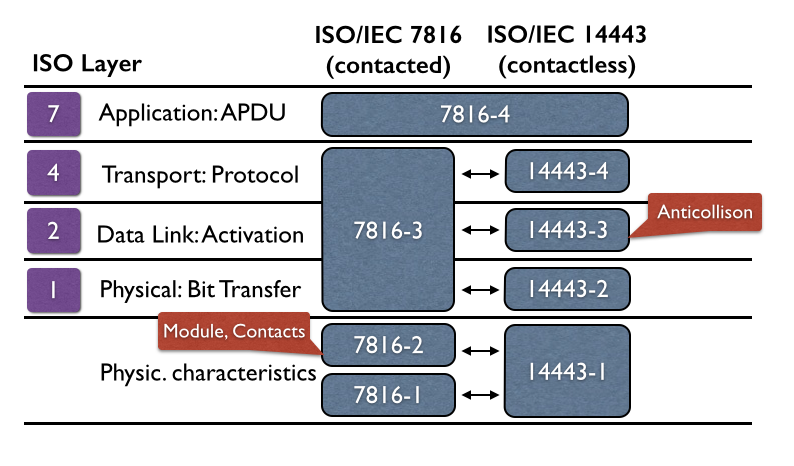Usually smart card applications base on international standards and norms. Also protocols mentioned here in this blog in context of ePassports, like Supplemental Access Control (SAC) or Password Authenticated Connection Establishment (PACE) are based on international ISO standards. The following figure shows the relevant ISO standards for contacted smart cards on the one side and contactless smart cards on the other side:
The main standard for contacted smart cards is ISO 7816, the main standard for contactless smart cards is ISO 14443. On application level both types of smart cards are using ISO 7816, where all commands (Application Protocol Data Unit, APDU) and files systems are described. Protocols are composed by these commands and using access rights and file systems specified in this standard. The standard ISO 7816-4 (Integrated circuit cards – Part 4: Organization, security and commands for interchange) is important for nearly all smart card applications. Using this standard enable applications to interoperate in various open environments, e.g. a credit card can be read by different terminals all over the world because credit card and terminal are using the same standard.
ISO 14443 specifies contactless mechanisms of smart cards. Smart cards may be type A or type B, both of them communicate via radio at 13.56 MHz. The main differences between these two types concern modulation methods, coding schemes (ISO 14443-2) and protocol initialization procedures (ISO 14443-3). Both types are using the same transmission protocol, described in ISO 14443-4. The transmission protocol specifies mechanisms like data block exchange and waiting time extension. In the contactless world a reader is called proximity coupling device (PCD) and the card itself is
called proximity integrated circuit card (PICC).


nice work, keep up the good work.
nice work, keep up the good work.
excellent
Great!
Thank you for sharing an informative article. thank you.